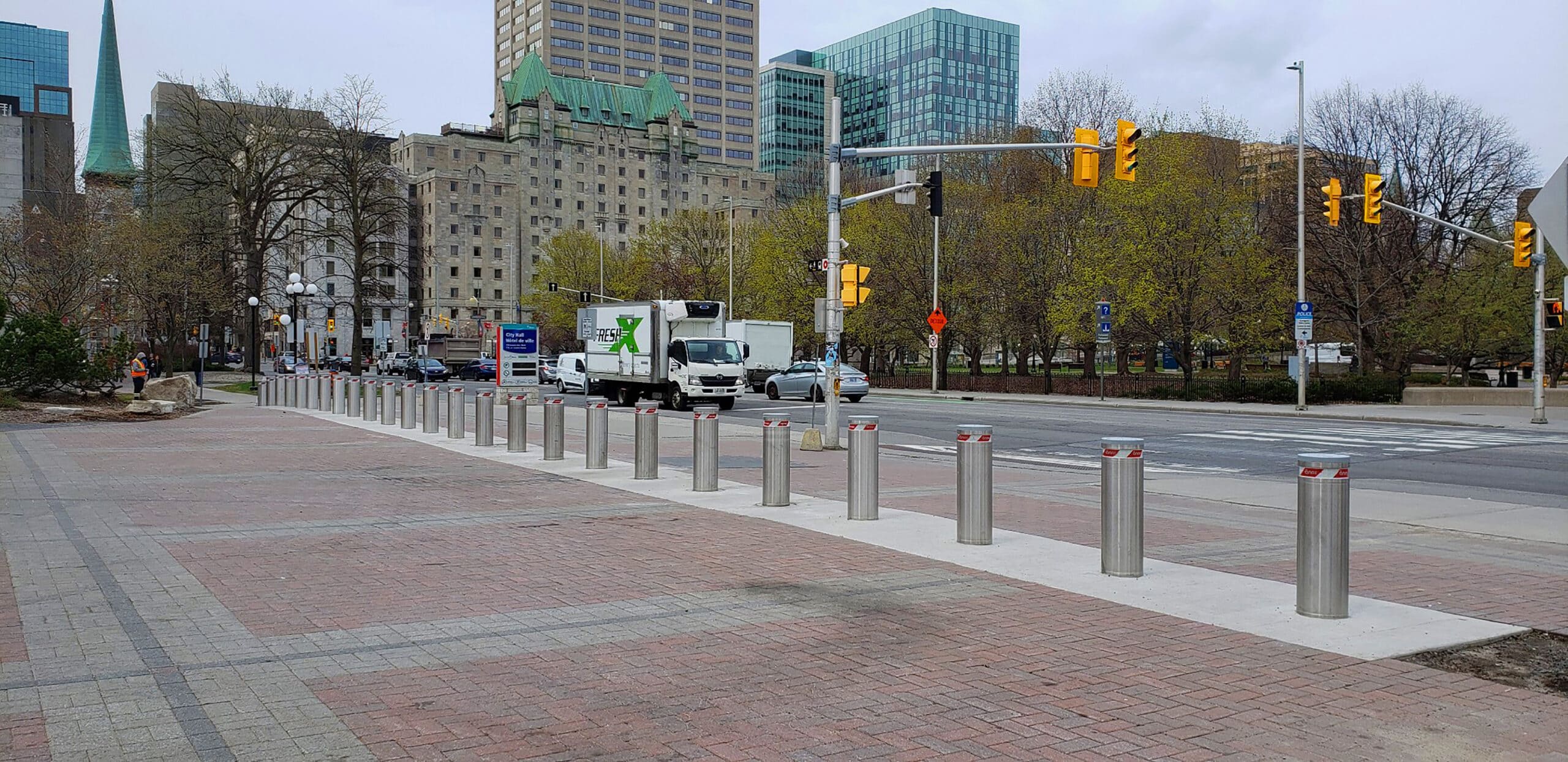Crash-Rated Bollards
The Evolution of Crash Rated and High Impact Bollards.

Bollards started out as simple posts that protected buildings from car accidents. Over time, they’ve become much more crucial in our cities. Today, bollards do more than just manage traffic and add beauty; they also protect us from terrorist attacks. These strong posts are designed to stop vehicles that might intentionally crash into crowded areas. As cities have grown and the need for safety has increased, bollards have evolved to meet these challenges. They play a key role in making public spaces safer for everyone.
Using Bollards for Perimeter Protection
As we worry more about safety and security in cities, using both high-impact and anti-terrorism bollards has become key for protecting areas around buildings. High-impact bollards are placed to stop everyday accidents like a car going off the road. Anti-terrorism bollards are put around places that are at higher risk, to stop vehicles involved in more serious threats. Together, these bollards create a strong barrier. They make people feel safer and ensure public spaces are both secure and welcoming. This shows our commitment to making city landscapes safer.
Understanding K-Ratings
K-ratings were developed in response to growing security needs, especially after events like 9/11 showed how vulnerable urban areas could be. The Department of Defense first created these ratings to measure how well security barriers like bollards can handle vehicle crashes. The ratings are based on whether a barrier can stop a 15,000-pound vehicle moving at speeds of 30, 40, or 50 miles per hour.
Standard K-ratings
| Ratings | Speed | Products |
| K4 | 30 mph (48 km/h) | Click Here |
| K12 | 50 mph (80 km/h) | Click Here |
These ratings help planners and security experts pick the right level of protection for different places. They make sure areas are safe from potential attacks. K-ratings have become a fundamental part of security planning in cities.
Introduction to ASTM Ratings
After K-ratings, ASTM ratings were introduced to give a more detailed way to measure how barriers like bollards perform against vehicle impacts. Developed by the American Society for Testing and Materials, these ratings look at how barriers stop different types and sizes of vehicles at various speeds.
For example, the ASTM F2656 standard checks how bollards handle impacts at speeds of 40, 50, and 60 mph. This detailed system lets us tailor security measures to the specific needs and threats of an area. Like K-ratings, ASTM standards help us choose the best security solutions for important places and keep up with changing threats.
Standard M Ratings
| Vehicle Size | ASTM Standard | Penetration Rating | ASTM Speed Rating | Products |
| Truck 15,000lbs | F2656 |
P1 = ≤ 3.3 ft P2 = 3.31–23.0 ft P3 = 23.1–98.4 ft P4 = > 98.4 ft
|
M30 (30 mph) M50 (50 mph) |
Click Here |
| Small Car | F2656 |
P1 = ≤ 3.3 ft P2 = 3.31–23.0 ft P3 = 23.1–98.4 ft P4 = > 98.4 ft |
C40 (40 mph) | Click Here |
Differences Between Rated and Non-Rated Bollards
Understanding the roles of crash-rated versus non-rated bollards is important. Crash-rated bollards are tested to meet strict standards, which means they can handle high-speed impacts from vehicles. This is crucial in places that might face terrorist attacks or severe threats. These bollards not only stop a vehicle but also control how far it can go after crashing, which is key to reducing damage and injuries.
Non-rated bollards, on the other hand, offer basic protection. They are good for controlling traffic or for decoration in less risky areas. They help with low-speed bumps or minor crashes but aren’t meant for stopping high-speed vehicle attacks.
How CRash Rated Bollards Are Installed
Installing crash-rated bollards is a complex and precise task. It starts with a detailed look at the site to understand the traffic and potential threats. This helps decide the best places for the bollards.
The bollards need a strong foundation, usually a deep, reinforced concrete base, to handle the impact of a crash. The bollards are then placed into these bases and connected to each other for extra strength. After they’re installed, the area around the bollards is fixed up, often with paving or landscaping, to make sure they fit well with their surroundings.
Professionals test the bollards to make sure they work as expected. This installation process needs skilled planners and builders to make sure the bollards do their job well.
Creating Secure Perimeters with Bollards
To make urban areas safe, planners use both traditional and crash-rated bollards together. Traditional bollards manage traffic and protect less critical areas. Crash-rated bollards are used where there’s a real risk of attack. They’re placed near important buildings or big public spaces to stop severe impacts.
Using these two types of bollards together helps keep public spaces open and friendly while making sure they are safe. This approach to security lets people enjoy their surroundings without worry.
